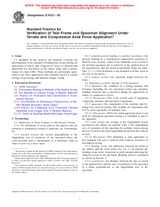We need your consent to use the individual data so that you can see information about your interests, among other things. Click "OK" to give your consent.
ASTM E1012-05
Standard Practice for Verification of Test Frame and Specimen Alignment Under Tensile and Compressive Axial Force Application
STANDARD published on 1.6.2005
The information about the standard:
Designation standards: ASTM E1012-05
Note: WITHDRAWN
Publication date standards: 1.6.2005
SKU: NS-40130
The number of pages: 11
Approximate weight : 33 g (0.07 lbs)
Country: American technical standard
Category: Technical standards ASTM
Annotation of standard text ASTM E1012-05 :
Keywords:
ICS Number Code 19.060 (Mechanical testing)
Additional information
| Significance and Use | ||||||||||||||||||||
|
It has been shown that bending stresses that inadvertently occur due to misalignment between the applied force and the specimen axes during the application of tensile and compressive forces can affect the test results. In recognition of this effect, some test methods include a statement limiting the misalignment that is permitted. The purpose of this practice is to provide a reference for test methods and practices that require the application of tensile or compressive forces under conditions where alignment is important. The objective is to implement the use of common terminology and methods for verification of alignment of test machines, associated fixtures and test specimens. Unless otherwise specified, axiality requirements and verifications should be optional when testing is performed for acceptance of materials for minimum strength and ductility requirements. This is because any effects especially from excessive bending, would be expected to reduce strength and ductility properties and give conservative results. There may be no benefit from improved axiality when testing high ductility materials to determine conformance with minimum properties. Whether or not to improve axiality should be a matter of negotiation between the material producer and the user. |
||||||||||||||||||||
| 1. Scope | ||||||||||||||||||||
|
1.1 Included in this practice are methods covering the determination of the amount of bending that occurs during the application of tensile and compressive forces to notched and unnotched test specimens in the elastic range and to plastic strains less than 0.002. These methods are particularly applicable to the force application rates normally used for tension testing, creep testing, and uniaxial fatigue testing. |
||||||||||||||||||||
| 2. Referenced Documents | ||||||||||||||||||||
|



 Cookies
Cookies
